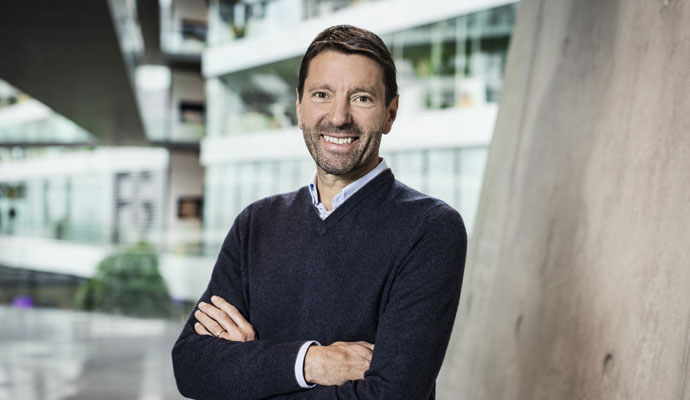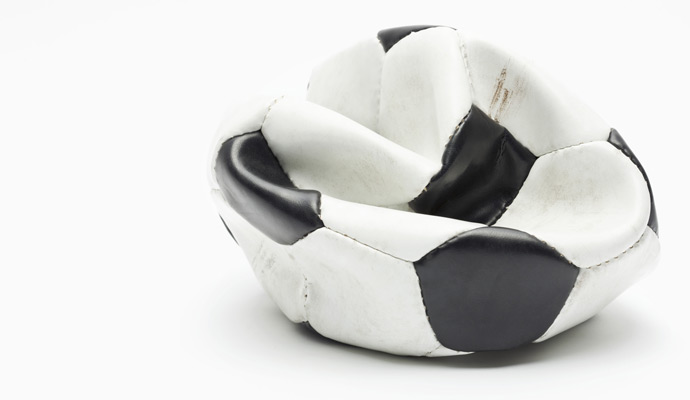Leading a Company That Wants to Change Lives through Sports
Adidas CEO Kasper Rørsted explains how to align business strategy and execution during a shift in global consumer demand.
This interview is part of the Inside the Mind of the CxO series, which explores a wide range of critical decisions faced by chief executives around the world.
Think high-profile consumer goods, and sports apparel comes quickly to mind. It has the most memorable slogans, the most famous brand ambassadors, and a rapid-fire, trend-catching production cycle for sleek new products. The sports apparel category is also expected to grow fast, at about 4 percent a year — a reflection of the increasing global interest in health and fitness. The market, with its dizzying array of custom footwear, is set to have annual sales of nearly US$190 billion by 2020.
For the past few years, the fastest-growing major sports apparel enterprise has been the German company that founded the sector in 1924: Adidas. The CEO overseeing Adidas’s flourishing is Kasper Rørsted, a man who spent the first half of his career in the tech industry and is known in business circles for his ability to link strategy and execution. He was hired in 2016 from the top post at Henkel, a manufacturer of laundry and beauty products, where he had led an eight-year turnaround that tripled the company’s share price.
Rørsted, originally from Denmark, is an avid athlete who once played on his country’s national youth handball team. Now, with the motto “Through sport, we have the power to change lives,” he is positioning Adidas as a globally influential enterprise. The Adidas strategy — speed, a focus on a few trendsetting cities, and open source innovation — was introduced in 2015 by Rørsted’s predecessor, Herbert Hainer, who had retired after running Adidas for 15 years. Rørsted continued promoting all three strategic priorities, and focused on execution. On his watch, Adidas reorganized its operations and launched two innovative “Speedfactories,” or rapid-production plants making customized athletic shoes, in Ansbach, Germany, and Atlanta. Its roster of celebrity partners includes musicians Kanye West (whose Adidas line has persisted through all of his public ups and downs) and Pharrell Williams, and designers Stella McCartney and Alexander Wang. Rørsted is also putting in place innovative management practices, including one of the few comprehensive employee stock ownership plans introduced by a major company in recent years.
Adidas has long been known for innovation. Founder Adolf (Adi) Dassler was a cobbler and amateur athlete in Herzogenaurach, a small Bavarian town where Adidas headquarters is still located. Dassler invented some of the first specialized footwear — for example, lightweight spiked shoes for football (soccer) and other sports.
When Adidas announced that the well-respected Rørsted was joining the company, its market cap gained about $1 billion. In conversation, the CEO is direct, matter-of-fact, and self-effacing. In August, he sat down with strategy+business at Adidas headquarters to talk about leadership in the digital age. Chief corporate communications officer Jan Runau also participated.
S+B: When you arrived at Adidas, you inherited your predecessor’s strategy. Many CEOs would have been tempted to change direction.
RØRSTED: I believe that you should change a company’s strategy only if there is a strong rationale for the change. From a numbers standpoint, our strategy was clearly successful. Instead of changing it, I tried to understand our approach to it more completely. We had made three strategic choices. Were we actually executing according to what [was] needed?
S+B: What were the three choices?
RØRSTED: Open source innovation, cities, and speed.
Open source innovation means that we look at all kinds of collaborative creation as valuable — not only within our company, but with external partners as well. This includes our branded relationships with well-known creative figures; our partnership with Parley for the Oceans, the environmental group, to create shoes from recovered ocean plastic; and [our partnership] with Daniëlle Cathari, a 23-year-old designer who was a student at the Amsterdam Fashion Institute when we began working with her.
S+B: How do you integrate that external innovation with your own internal R&D?
RØRSTED: We see them as complementary. We are clear about the borders of our brand, because the brand is sacred to us. But we also recognize that if we have only the inspiration and creativity of people within our own organization, we miss a lot of what’s going on in the marketplace. Our thought was: How do we complement internal with external innovation to get the best products?
A few of our in-house designers needed to get used to the fact that they were not competing with outsiders; they were being complemented. We articulated this point by saying that we need to be consumer-obsessed and to create the best product for the consumer. If that is your endgame, then you have to be able to confront sacred cows, and open yourself up to ideas that you might not have been open to in the past.
Think Cities, Act Global
S+B: What is the Adidas cities strategy?
RØRSTED: The world has become much more open than it’s ever been. Trends with origins in the big cities have a fundamental global impact, fueled by the reach of digital devices. When something occurs in Shanghai or New York, kids all over the world see it immediately. This means that we can focus our marketing in just a few of the world’s major cities.
“When something occurs in Shanghai or New York, kids all over the world see it immediately. This means that we can focus our marketing in just a few of the world’s major cities.”
We did not have that view before. Our perspective had been based on countries. In our company, every country had its own marketing strategy. Now we have become more prescriptive: We can launch all our key products in just a few cities and the countries will pick this up. We identified six key cities to start with: London, Paris, New York, Los Angeles, Shanghai, and Tokyo. We realized that if we can dominate those cities, not only in terms of market share and customer loyalty, but also by capturing creative ideas coming up in them, we can have a much greater impact on our global markets. Any trend coming out of these cities, whether it’s fashion or technology, will have global impact. And conversely, if we’re not where the trends originate, then we’re most certainly going to miss some of them.
S+B: You recently opened a store in New York.
RØRSTED: On Fifth Avenue. We’re about to open one in London, we’re developing one in Paris, and we just opened one in Shanghai. We use these stores as activation vehicles for product launches, to capture brand exposure more than commercial value. For instance, last year we created the largest basketball event we’ve ever held, called 747 Warehouse St., in Los Angeles. And in our physical store in New York we launched our 4D Carbon line, which is a shoe made through digital light synthesis. New York represents only 6 percent of the U.S. GDP, but the impact of New York from a global fashion standpoint is huge.
S+B: Tell us about your speed strategy.
RØRSTED: How do we enable our supply chain to respond to rapid changes in consumer demand? Our supply chain had been more rigid than most. That meant the demand forecasts for any given item were always wrong — either too high or too low. Now we use technology to speed up our operations. We built our two Speedfactories, in Germany and Atlanta, using digital technologies like 3D printing to enable faster production and get closer to a real-time supply chain.
S+B: You’re talking about making shoes to order.
RØRSTED: Eventually, yes. But the difference between us and a car manufacturer is that last year, we manufactured a billion products and 400 million pairs of shoes. For some of those, we are getting closer and closer to making them to order. In a Speedfactory, with 3D, the order-to-deliver time can be days instead of months. But that is not at volume. At high volume, we’re currently in a 30- or 60-day time frame. And if we see demand picking up, we need to be able to change our volumes.
S+B: Does manufacturing at higher speed reduce your costs?
RØRSTED: Yes. One of the biggest costs we have is returns. We order a million pairs of shoes, and if they don’t sell, we sit with 800,000 pairs in inventory. Add to that opportunity cost when we don’t actually satisfy customer demand. Nonetheless, our speed strategy is not primarily about reducing costs. The goal is to meet demand better by delivering more speedily to the consumer.
Accelerators for Strategy
S+B: Do you see these three strategic choices as imperatives for every successful company?
RØRSTED: For Adidas, they are highly relevant. But I couldn’t say that these initiatives would be equally relevant for every company. Open source, yes. Speed, to a lesser extent. It would depend on the dynamics within the industry, and also, the strategic position of different elements within the company.
S+B: How do you translate your strategic priorities into day-to-day execution?
RØRSTED: Shortly after I came in, we defined four “accelerators” of the strategy. These are operational elements that ensure that we become very disciplined in getting things done. They are generating significant value for our company. The first is reviewing our portfolio. The second, improving our position in North America. Third is “One Adidas”: being best in class in operational excellence and getting more scale into our business model. And the fourth is digital.
S+B: What are you doing with respect to your portfolio?
RØRSTED: We define our portfolio in terms of subgroups, entities organized by brand, country, and strategic business unit. On a quarterly basis, we look at the 10 lowest-performing entities in terms of profitability, and put action plans in place for them. Then we review our progress on a quarterly basis by country.
One example was Brazil. Before 2012, everybody expected Brazil to rule the sports world. It had the World Cup and Olympics coming up. So we overbuilt our organization there. Later, we put a restructuring plan in place to get Brazil back to profitability.
Another example was our outdoor [apparel] business, which we didn’t believe was getting the right level of focus within the organization. We put it into a different building, and gave those people freedom to change their operating model. A third example: We decided we didn’t want to be in golf or hockey equipment, so we sold those businesses.
S+B: Every company tries to focus its portfolio. Not everyone succeeds. How does one make it work?
RØRSTED: Being disciplined about what you say you’re going to do. Putting in key performance indicators to which you hold people accountable, including their compensation. For the restructuring of Reebok (the U.K.-origin athletic footwear and apparel company that Adidas acquired in 2005), the management board is accountable; we go through the numbers rigorously each quarter, driving accountability and rewarding people accordingly. That can be an uncomfortable process. But it’s the only way you can succeed, because people don’t like to do things that are uncomfortable, even when they have to be done.
S+B: Why did you decide you needed a separate accelerator for North America?
RØRSTED: It is the single biggest market in the world — and the only global market of any significance where we are underrepresented. Ninety percent of the size difference between us and Nike comes back to the difference in our North America businesses. Years ago, we sent over European executives who didn’t understand American sports. We didn’t know baseball, basketball, and American football; we didn’t appreciate that sport in the U.S. originates in high school and college instead of in clubs (as it does in Europe). We created products that were great for Europeans but not necessarily for Americans.
We had already begun to change this before I arrived. But I looked at it again and concluded that we needed to overinvest in America over a longer period of time, to ensure that we could build market share and margin.
In other regions we have different strategies, because we have different goals. We’re trying to defend a high market position in Europe; in China, we’re trying to grow a strong market position but defend our margin.
Focused Execution
S+B: It sounds like your strategy is oriented toward long-term investments.
RØRSTED: There is no long term without the short term. You need to get both right. You can be oriented toward quarterly results and still have long-term goals. Our management board compensation has two components: long-term incentives based on our 2020 targets and short-term incentives. It’s like being in university; you have to pass every exam along the way. You can’t just wait until the last quarter and try to catch up.
Not every decision can be long-term. If a market suddenly slows down, as Europe is right now, you need to act [in a way that’s] relevant to that change. I think a lot of companies underestimate the importance of getting the daily job done in a way they can be proud of. Leaders think they get famous for strategy, and they don’t really focus on the everyday execution, because they think you don’t get famous for that. But unless you have good execution in place, you will struggle with growth, because the operational foundation on which you grow is fragile.
For example, we have outgrown our infrastructure in the United States. During the second half of last year, we missed revenue because our distribution system simply couldn’t keep up with our demand. In a sense, this was a self-created problem. We saw it coming, and nobody dealt with it. It’s cumbersome to create new warehouses. Then, suddenly, we had a problem. That’s why operational excellence — our One Adidas initiative — is so fundamental for our company. It helps us avoid creating problems for ourselves.
S+B: What’s involved in the One Adidas initiative?
RØRSTED: Our company has always been very good at generating top-line [results], but without leverage over costs. We added €9 billion (US$11.6 billion) to our top line between 2008 and 2016 with no change in operating margin. One Adidas is about improving operational excellence, so we get scale into our business model. And we are building consistency into our data sets.
RUNAU: Adidas historically operated through strong country-based organizations. It grew basically from the bottom up, and each country created its own systems. We are bringing them together. Thus, for example, in 2014, we had more than 50 different intranet sites around the globe. Now we have one.
RØRSTED: If I have a message to send employees, for example, to describe a decision the board has made, I send one message globally. In 2014, our system couldn’t do that. Back then, employees didn’t really know what was coming through the system.
Digital Best in Class
S+B: You mentioned wanting to be “best in class” in operational excellence. What’s an example of something you’d want to be known for?
RØRSTED: That takes us to our fourth accelerator: digital. We called out digital as an enabler because we did not have enough of a company-wide focus on it, or frankly the right competencies on board. So we created a digital leadership team to look at all of the projects across the company. We did not want to have one comprehensive digital agenda. Instead, we split the digital agenda into important projects that we could execute quickly and meaningfully. If you try to build Rome all at once, it never happens in time.
Digital has a tremendous impact on the way that you can tailor your product to individual athletes. You can have a customized midsole in your running shoe, adjusted for the shape of your foot. This type of customization will grow more popular over time, starting at the high end. We produced 5,000 pairs of those customized shoes in 2017, and we’ll probably make almost 100,000 in 2018. Eventually, we’ll be producing a million a year.
S+B: Will you use 3D printing to produce shoes to order, sold right from pop-up digital factories? And if you don’t, are you afraid that a competitor or a retailer might?
RØRSTED: You’ll see that technology coming up more and more, but consider the numbers. We made 402 million pairs of shoes in 2017. Our Speedfactories, when they are fully running, will make 500,000 pairs each, annually. Local pop-up factories will happen, but they will be marginal in the bigger picture. I don’t think new competitors or private labels will be a threat for branded athletic wear. People still want the three stripes and the swoosh, and I don’t think that will change.
S+B: Given the growth of platform manufacturing, will the factory and the brand split apart, with operations shared across the industry?
RØRSTED: That’s almost happening today. All our manufacturing is outsourced. And if you go to Vietnam, you will find the same suppliers making products for us and for Nike and other sports brands. The value creation takes place in design and in the materials and functionality. Less in the physical build of the product.
We are also improving consumer experience. We launch new products every week, and the most effective way of launching products is through digital media. We’re particularly interested in mobile devices. We have to be world class at that; if we’re not, we can’t win, because at the end of the day, we are a consumer company. And our primary engagement vehicle is the smartphone.
We gave our e-commerce group — the group that manages Adidas.com and Reebok.com — a target. We had sold €700 million (US$777 million) through our site in 2015, about €1 billion (US$1.1 billion) in 2016. We set a target of €4 billion (about US$4.6 billion) in annual revenues by 2020. To meet that target, the team has control over its hiring, organizational structure, and compensation system. We don’t know if it is achievable, but we know that by putting a very aggressive plan in place, we will drive the right mind-set.
In 2016, we said publicly for the first time that our online store was our most important store globally — period. This made it clear to everyone in the company that we were changing our priorities. We would start deliberately cannibalizing our own infrastructure. It also provokes conflict with partners. We sold the World Cup jerseys this year exclusively on Adidas.com for the first two weeks. Our wholesale partners were shouting: “Why are you doing this?” The answer, of course, was that it was necessary: We have to be where the consumer is — and this is online.
In general, the clearer we can be in formulating and articulating our strategy, and the clearer we become in saying, “Here is what ‘good’ looks like,” the easier it is to go through this change. For example, any new product now must be launched either online by itself or online in combination with our six key cities. Not everybody will like this.
S+B: It sounds like you see the company’s chances for success as less a matter of external threats or trends, and more a matter of your own decisions and execution.
RØRSTED: We know the sports apparel industry will continue to grow. Sports are increasingly popular around the world. The need to combat obesity is driving people to be more athletic. And there are trends toward leisure and more relaxed clothing in the office. In contrast to other sectors, we are not seeing consolidation; we’re seeing accelerated growth. If we were in another industry, growing 2 percent per year, we would need to raise our leverage and look for a larger market. But if you’re in an industry that is growing 5 percent or more, like ours, then your biggest opportunity is to get your company in top shape, because the market will be there.
Author profiles:
- Ulrich Störk is chairman of the management board for PwC Germany and a partner based in Frankfurt.
- Nadia Kubis is a director with PwC Switzerland and global director of the Capabilities-Driven Strategy and Growth platform.
- Art Kleiner is editor-in-chief of strategy+business.





